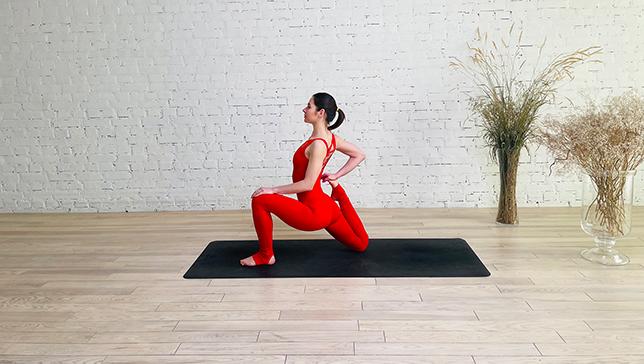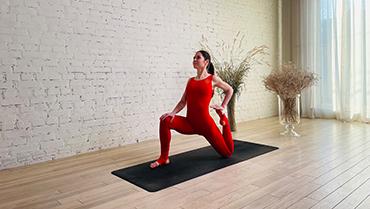King Arthur Pose - Virabhadrasana Variation

Contents
King Arthur’s Pose or Virabhadrasana Variation is not one of the most common poses. King Arthur’s pose targets the front of the quadriceps in a deep, delicious way. The lunge variation stretches the iliopsoas (what people commonly refer to as the hip flexors).
Is variation are great general pose for runners, walkers, those who sit at a desk, those who drive, pretty much everyone. Also wonderful variation for backbends.
Pose Detail
- By Type: Balancing Yoga Poses, Chest Opening Yoga Poses, Shoulder Opening Yoga Poses, Strengthening Yoga Poses
- Difficulty: Beginners
- Body Position: Standing Yoga Poses
- By Benefit: Yoga Poses For Digestion
Step-by-Step Instructions
Benefits and Contraindications
Tones the abdomen
Increases focus and steadiness
Strengthens and stretches the thighs, calves, and ankles
Helps to open, heal, and balance all chakras
Back problems
High blood pressure
Neck problems
Migraine
Photo poses in different angles

Modifications and Props for Beginners
- If kneeling is uncomfortable, you can place a blanket or a yoga block under your knee for support.
- If your back leg feels strained, you can slide a blanket or a yoga block under your back thigh to provide support.
Useful Tips
- As with any yoga pose, listen to your body and work within your own range of motion.
- If you feel any pain or discomfort, modify the pose or come out of it.
- It is important to always maintain proper alignment and engage the core muscles to protect the lower back.
Frequently Asked Questions
If you have knee or hip issues, you may want to avoid deepening the bend in your front knee. You can also use a block or blanket to support your front thigh if you need extra support. Additionally, you can practice the pose with your back foot turned in slightly if you have trouble balancing.
Here are some common mistakes to avoid when practicing King Arthur Pose:
- Hunching the shoulders: This can lead to tension in the neck and shoulders, and may also make it more difficult to breathe deeply.
- Leaning forward: The torso should be upright and the spine long. Leaning forward can place unnecessary strain on the lower back.
- Collapsing the front knee inward: The front knee should be stacked directly over the ankle, and the thigh should be parallel to the ground. Collapsing the knee inward can put pressure on the knee joint.
- Overextending the front knee: The knee should be bent at a comfortable angle, typically around a 90-degree angle. Overextending the knee can lead to strain or injury.
- Tucking the pelvis under: The pelvis should be neutral, not tilted forward or backward. Tucking the pelvis can cause compression in the lower back.
- Gripping the toes: The toes should be relaxed, not clenched or gripping the ground. This can lead to tension in the feet and ankles.
- Holding the breath: It’s important to breathe deeply and evenly throughout the pose. Holding the breath can increase tension and limit the benefits of the pose.
By avoiding these common mistakes, you can practice King Arthur Pose safely and effectively.
Here are some poses that can complement King Arthur Pose and create a well-rounded yoga practice:
- Downward Facing Dog: This pose helps to stretch and strengthen the arms, shoulders, and back muscles, while also stretching the calves and hamstrings.
- Triangle Pose: This pose stretches and strengthens the legs, hips, and spine, while also helping to open the chest and shoulders.
- Extended Side Angle Pose: This pose is similar to King Arthur Pose, but with the front arm reaching forward and the hand placed on the ground or a block. It helps to stretch and strengthen the legs and hips, while also opening the chest and shoulders.
- PPigeon Pose: This pose is a great way to stretch the hips and glutes, which can become tight from sitting for long periods of time.
- Cobra Pose: This pose helps to strengthen the back muscles, while also stretching the chest and shoulders.
- Child Pose: This gentle resting pose helps to stretch the back, hips, and thighs, while also calming the mind and reducing stress.
Incorporating these poses into your practice can help to balance out the benefits of King Arthur Pose and create a well-rounded yoga routine.
Here are some tips on how to get the most out of the King Arthur pose:
- Warm up: It’s important to warm up the body before practicing King Arthur Pose, as this pose can be quite demanding on the legs and hips. Consider doing some gentle stretching to warm up the muscles and prepare the body for the pose.
- Focus on alignment: Pay attention to the alignment of the legs and hips, making sure that the front knee is stacked directly over the ankle and the hips are squared forward. Keep the spine long and the shoulders relaxed.
- Breathe deeply: Take deep, even breaths throughout the pose, inhaling and exhaling through the nose. This can help to calm the mind and reduce tension in the body.
- Hold the pose for several breaths: Aim to hold King Arthur Pose for at least 5-10 deep breaths, or longer if comfortable. This can help to build strength and endurance in the legs and hips.
- Release the pose slowly: When coming out of the pose, release slowly and mindfully, taking care not to strain any muscles or joints.
By following these tips and practicing King Arthur Pose regularly, you can improve your strength, flexibility, and overall well-being.